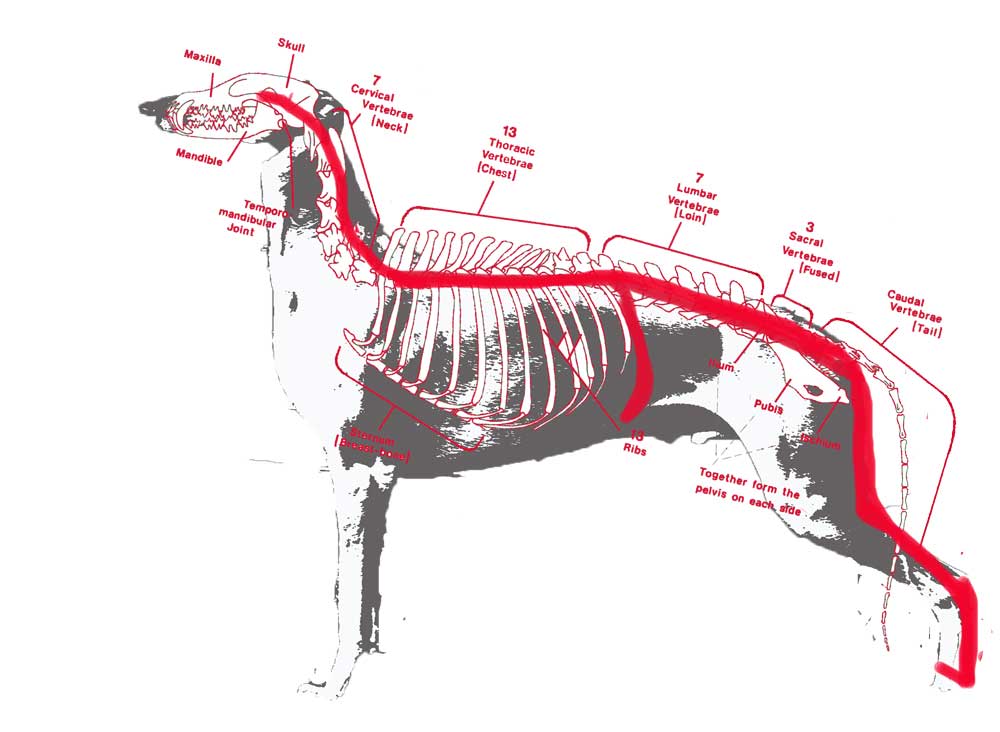In a greyhound the top line and under line are very important. There are a lot of details that can be different these anatomical parts.
Starting from the standard description of the body:
BODY:
Back: Rather long, broad and square.
Loin: Powerful, slightly arched.
Chest: Deep and capacious, providing adequate heart room. Ribs
deep, well sprung and carried well back.
Underline and belly: Flanks well cut up.
Greyhound is a series of flowing curves with length of limb, bone, frame and height, not low-to-the-ground rectangles or ‘cobby’ squares. The amalgamation of the length, shape and curvature of vertebrae of the spinal column conjointly with the hard, smooth muscling encapsulating, supporting the loin area create the characteristic, conspicuous and prominent arch over the loin.
These, together with the great breadth across the loin and pelvis, the balanced length of the femur, (first thigh) and tibia (second thigh) enable the beautiful, greyhound-like topline. Most technical terms define topline as the point over the withers with its thirteen thoracic vertebrae, continuing rearwards on the vertebral column and its seven lumbar vertebrae (loins) and over the three sacral vertebrae.
A fluid greyhound-like topline begins on the plane of the skull, over the occiput and glides down over a powerful, arched, well-set neck with depth. It continues to flow over the shoulder, the anticlinal vertebrae and begins to rise gradually at this point past the seventh floating rib on and over arched loins of great breadth, carrying over the croup junction, descending along a broad, thirty degree sloped croup finally skimming down the tail. (Hounds – Toplines & Underlines by Lisa Dubé Forman)
The greyhound study book, pubblished in 2007 by the American Greyhound Kennel Club is specific and very detailed in describing greyhound top line.
Greyhound top line is composed by four part of the dog: neck, back, loin and crop:
NECK
The neck is long, strong and gently arched with muscle, flowing and widening smoothly into the shoulders and withers.A well-attached neck is associated with a good lay-back of shoulders, and will be set well back onto the body with the rise at the withers barely perceptible.
BACK
In the Greyhound standard, the back represents the dorsal (upper) surface of the dog from withers to the base of the rib cage (the thoracic portion of the spine). This portion of the spine is relatively level from the withers to the attachment of the loin muscles. The transition at the attachment of the loin muscles over the last three ribs blends smoothly into the arch of the loin. When in peak condition, strips of muscling on both sides of the back and over the loin will be evident, creating the broad, strong, well-arched top line that is distinctively Greyhound.
The length of the thoracic portion of the back and the length of the loin may vary slightly but they are relatively similar in length.The proportions should result in a dog that looks strong, purposeful, and capable of the double suspension gallop.
LOINS
The loin must be well arched in top line and underline to give the Greyhound its characteristic power and shape.The loin must be of sufficient length to allow flexing as the dog moves from the folded position to the extended position at the gallop.A rigid, inflexible loin will not fully extend at the gallop. A flat loin will have to work much harder to contract at the gallop.
There should be no doubt that the Greyhound in profile is neither a Pointer, Doberman, Rottweiller, nor Whippet or Italian Greyhound.
Here a list of faults regarding top line:
Broken top line
Broken top line is a bad faults because dissipate energy during the gait lin the transmission of the impulse from the back to the front.
Kiphotic Top line
A Kiohotic top line present an arced loin too high, that interest not only the lombar region, but it start immediately behind the withers, also affecting the back.
Saddle Top Line
Saddle top line is a fault due to a too much long body.
From "Il Greyhound, un allevatore racconta" Gilberto Grandi
Error









